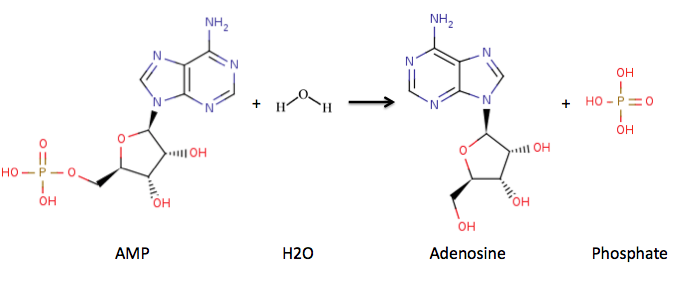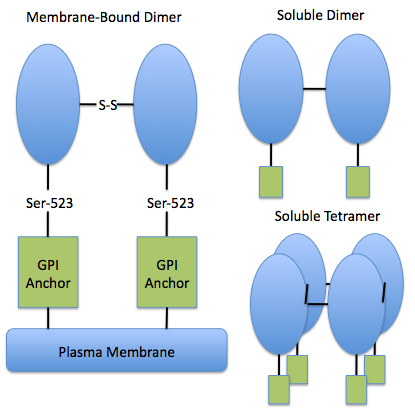5'-nucleotidase on:
[Wikipedia]
[Google]
[Amazon]
5′-Nucleotidase (EC 3.1.3.5) is an enzyme which catalyzes the phosphorylytic cleavage of 5′-nucleotides. Although originally found in snake venom, the activity of 5'nucleotidase has been described for bacteria and plant cells, and is widely distributed in vertebrate tissue. In mammalian cells the enzyme is predominantly located in the plasma membrane and its primary role is in the conversion of extracellular nucleotides (e.g. 5'-AMP), which are generally impermeable, to the corresponding nucleoside (e.g. adenosine) which can readily enter most cells. Consequently, the enzyme plays a key role in the metabolism of nucleotides.
The enzyme has a wide substrate specificity for 

 Studies of mammalian 5′-nucleotidases have shown that there exist at least four different forms of the 5′-nucleotidase enzyme: one membrane-bound form and three soluble forms. The membrane-bound form is anchored to the plasma membrane via GPI at its C-terminus. One of the soluble forms appears to be derived from the GPI-anchored ex-5'-nucleotidase and has an extracellular location. The two cytosolic forms of the enzyme have similar characteristics, but can be differentiated on the basis of their preferential affinities for nucleotide substrates. The GPI-anchored form exists as a dimer, with the two subunits linked via a disulfide bridge. The soluble forms can exist as dimers or tetramers. Generally at least 50% of the enzyme is found in the surface-bound form.
Studies of mammalian 5′-nucleotidases have shown that there exist at least four different forms of the 5′-nucleotidase enzyme: one membrane-bound form and three soluble forms. The membrane-bound form is anchored to the plasma membrane via GPI at its C-terminus. One of the soluble forms appears to be derived from the GPI-anchored ex-5'-nucleotidase and has an extracellular location. The two cytosolic forms of the enzyme have similar characteristics, but can be differentiated on the basis of their preferential affinities for nucleotide substrates. The GPI-anchored form exists as a dimer, with the two subunits linked via a disulfide bridge. The soluble forms can exist as dimers or tetramers. Generally at least 50% of the enzyme is found in the surface-bound form.
nucleotide
Nucleotides are organic molecules consisting of a nucleoside and a phosphate. They serve as monomeric units of the nucleic acid polymers – deoxyribonucleic acid (DNA) and ribonucleic acid (RNA), both of which are essential biomolecule ...
s and has been shown to hydrolyze 5'nucleotides rapidly, ribose-5-phosphate slowly, and other phosphate esters extremely slowly (if at all).
The enzyme catalyses the following reaction:
: a 5′-nucleotide
Nucleotides are organic molecules consisting of a nucleoside and a phosphate. They serve as monomeric units of the nucleic acid polymers – deoxyribonucleic acid (DNA) and ribonucleic acid (RNA), both of which are essential biomolecule ...
+ H2O a nucleoside
Nucleosides are glycosylamines that can be thought of as nucleotides without a phosphate group. A nucleoside consists simply of a nucleobase (also termed a nitrogenous base) and a five-carbon sugar (ribose or 2'-deoxyribose) whereas a nucleoti ...
+ phosphate
In chemistry, a phosphate is an anion, salt, functional group or ester derived from a phosphoric acid. It most commonly means orthophosphate, a derivative of orthophosphoric acid .
The phosphate or orthophosphate ion is derived from phosph ...
The 5′-nucleotidase-catalyzed reaction of an AMP #REDIRECT Amp
{{Redirect category shell, {{R from other capitalisation{{R from ambiguous page ...
nucleotide to adenosine nucleoside is shown below:

Nomenclature
*Accepted Name: 5′-nucleotidase *Systematic Name: 5′-ribonucleotide phosphohydrolase *Synonyms: uridine 5′-nucleotidase, 5′-adenylic phosphatase, adenosine 5'-phosphatase, AMP phosphatase, adenosine monophosphatase, 5′-mononucleotidase, AMPase, UMPase, 'snake venom 5'-nucleotidase, thimidine monophosphate nucleotidase, 5′-AMPase, 5′-AMP nucleotidase, AMP phosphohydrolase, IMP 5′-nucleotidase'')''.Structure

Active site
Studies of the soluble form of human ecto-5′-nucleotidase, without a GPI anchor, have shown that the C-terminal domain holds the substrate-binding pocket, and that the aromatic purine motif of the substrate is stacked between two phenylalanine residues. Furthermore, a catalytic mechanism has been proposed involving an in-line nucleophilic attack by a hydroxyl moiety that is coordinated by zinc on the substrate phosphorus, with the nucleoside acting as a leaving group.Membrane-bound and soluble forms
 Studies of mammalian 5′-nucleotidases have shown that there exist at least four different forms of the 5′-nucleotidase enzyme: one membrane-bound form and three soluble forms. The membrane-bound form is anchored to the plasma membrane via GPI at its C-terminus. One of the soluble forms appears to be derived from the GPI-anchored ex-5'-nucleotidase and has an extracellular location. The two cytosolic forms of the enzyme have similar characteristics, but can be differentiated on the basis of their preferential affinities for nucleotide substrates. The GPI-anchored form exists as a dimer, with the two subunits linked via a disulfide bridge. The soluble forms can exist as dimers or tetramers. Generally at least 50% of the enzyme is found in the surface-bound form.
Studies of mammalian 5′-nucleotidases have shown that there exist at least four different forms of the 5′-nucleotidase enzyme: one membrane-bound form and three soluble forms. The membrane-bound form is anchored to the plasma membrane via GPI at its C-terminus. One of the soluble forms appears to be derived from the GPI-anchored ex-5'-nucleotidase and has an extracellular location. The two cytosolic forms of the enzyme have similar characteristics, but can be differentiated on the basis of their preferential affinities for nucleotide substrates. The GPI-anchored form exists as a dimer, with the two subunits linked via a disulfide bridge. The soluble forms can exist as dimers or tetramers. Generally at least 50% of the enzyme is found in the surface-bound form.
Medical relevance
5' Nucleotidase blood test
The concentration of 5’nucleotidase protein in the blood is often used as aliver function test
Liver function tests (LFTs or LFs), also referred to as a hepatic panel, are groups of blood tests that provide information about the state of a patient's liver. These tests include prothrombin time (PT/INR), activated partial thromboplastin ti ...
in individuals that show signs of liver problems. The combined assays of serum 5'nucleotisase and alkaline phosphatase (AP) activities are extremely helpful in differential diagnosis since serum 5'nucleotidase activity is increased in obstructive hepatobiliary
The biliary tract, (biliary tree or biliary system) refers to the liver, gallbladder and bile ducts, and how they work together to make, store and secrete bile. Bile consists of water, electrolytes, bile acids, cholesterol, phospholipids and ...
disorders, but not in osseous disorders, whereas serum AP activity is generally increased in both categories of diseases. In other words, the test is used to determine if elevated protein levels are due to skeletal damage or liver damage. Normal levels of 5’nucleotidase are 2-17 units per liter. Elevated levels may indicate cholestasis
Cholestasis is a condition where bile cannot flow from the liver to the duodenum. The two basic distinctions are an obstructive type of cholestasis where there is a mechanical blockage in the duct system that can occur from a gallstone or malig ...
, destruction of liver cells, hepatitis
Hepatitis is inflammation of the liver tissue. Some people or animals with hepatitis have no symptoms, whereas others develop yellow discoloration of the skin and whites of the eyes ( jaundice), poor appetite, vomiting, tiredness, abdominal ...
(liver inflammation), liver ischemia, a liver tumor, or use of liver-damaging drugs. Pregnancy and certain medications (acetaminophen, halothane, isoniazid, methyldopa, nitrofurantoin) may interfere with the test.
The test may also be referred to as 5'NT Levels Blood Test, CDF73 Levels Blood Test, and Ecto-5'-Nucleotidase Levels Blood Test.
Lymphocyte 5'nucleotidase in immunological disorders
Ecto-5'Nucleotidase is considered a maturation marker forT cells
A T cell is a type of lymphocyte. T cells are one of the important white blood cells of the immune system and play a central role in the adaptive immune response. T cells can be distinguished from other lymphocytes by the presence of a T-cell re ...
and B cells
B cells, also known as B lymphocytes, are a type of white blood cell of the lymphocyte subtype. They function in the humoral immunity component of the adaptive immune system. B cells produce antibody molecules which may be either secreted o ...
. This is due to the fact that the enzyme activity is approximately 10-times higher for peripheral T cells than thymocyte
A Thymocyte is an immune cell present in the thymus, before it undergoes transformation into a T cell. Thymocytes are produced as stem cells in the bone marrow and reach the thymus via the blood. Thymopoiesis describes the process which turns thymo ...
s, 5-6 times higher in adult peripheral B cells than fetal B cells, and largely absent in non-T cell and non-B cell lymphocytes. In immunodeficiency diseases with arrested lymphocyte maturation, ex-5'nucleatidase activity is generally low. Such diseases include severe combined immuno-deficiency, Wiskott–Aldrich syndrome
Wiskott–Aldrich syndrome (WAS) is a rare X-linked recessive disease characterized by eczema, thrombocytopenia (low platelet count), immune deficiency, and bloody diarrhea (secondary to the thrombocytopenia). It is also sometimes called the eczem ...
, congenital X-linked agammaglobulinemia, selective IgA deficiency and acquired immune deficiency syndrome ( AIDS).
Relation to lead poisoning
Numerous studies have shown that erythrocyte pyrimidine 5′-nucleotidase activity is significantly lowered in patients with lead poisoning, and that pyrimidine 5′-nucleotidase activity can be used as an index of lead poisoning. It is believed that lead induced deficiency of the enzyme in maturing erythroid cells is responsible for basophilic stippling andhemolysis
Hemolysis or haemolysis (), also known by several other names, is the rupturing ( lysis) of red blood cells (erythrocytes) and the release of their contents (cytoplasm) into surrounding fluid (e.g. blood plasma). Hemolysis may occur in vivo ...
in a manner analogous to the pathogenesis of the hereditary enzyme deficiency syndrome. The mechanism of inhibition of 5'nucleotidase in lead poisoning may contribute to the hemolytic
Hemolysis or haemolysis (), also known by several other names, is the rupturing (lysis) of red blood cells (erythrocytes) and the release of their contents (cytoplasm) into surrounding fluid (e.g. blood plasma). Hemolysis may occur in vivo o ...
syndromes that occur in patients with acute lead poisoning. Since erythrocyte pyrimidine 5'NT activity is inhibited ''in vitro'' by various metals (e.g., copper, zinc, cadmium, lead, mercury, and tin), it is likely that inhibition of pyrimidine 5'nucleotidase may contribute to the hemolytic syndromes that occur in patients with acute poisoning by these metals.
Cytosolic 5-nucleotidase II superactivity
Cytosolic 5-nucleotidase II superactivity has been associated withautism spectrum disorder
The autism spectrum, often referred to as just autism or in the context of a professional diagnosis autism spectrum disorder (ASD) or autism spectrum condition (ASC), is a neurodevelopmental condition (or conditions) characterized by difficulti ...
via a disorder of carnitine biosynthesis.
References
External links
* {{Portal bar, Biology, border=no EC 3.1.3